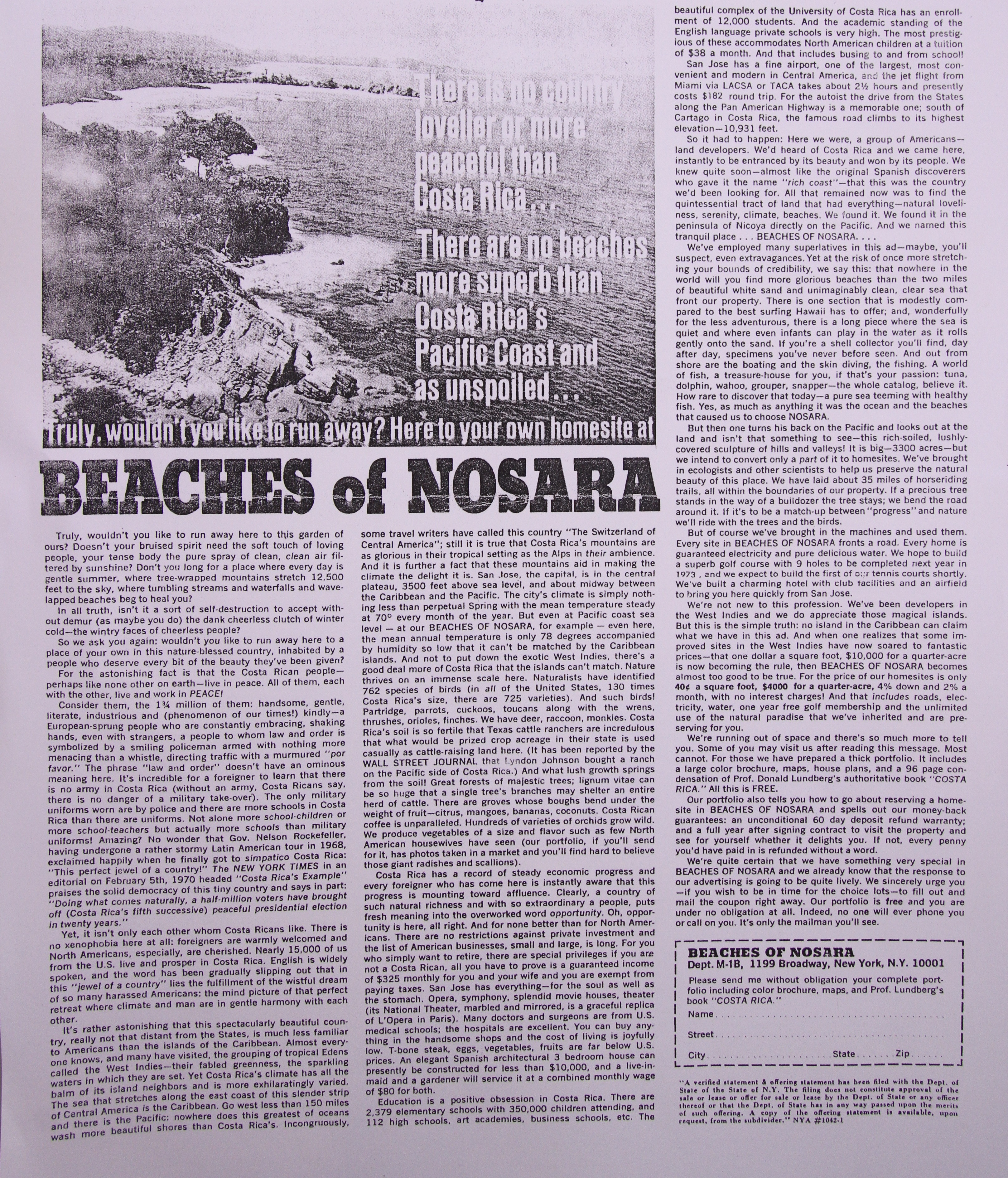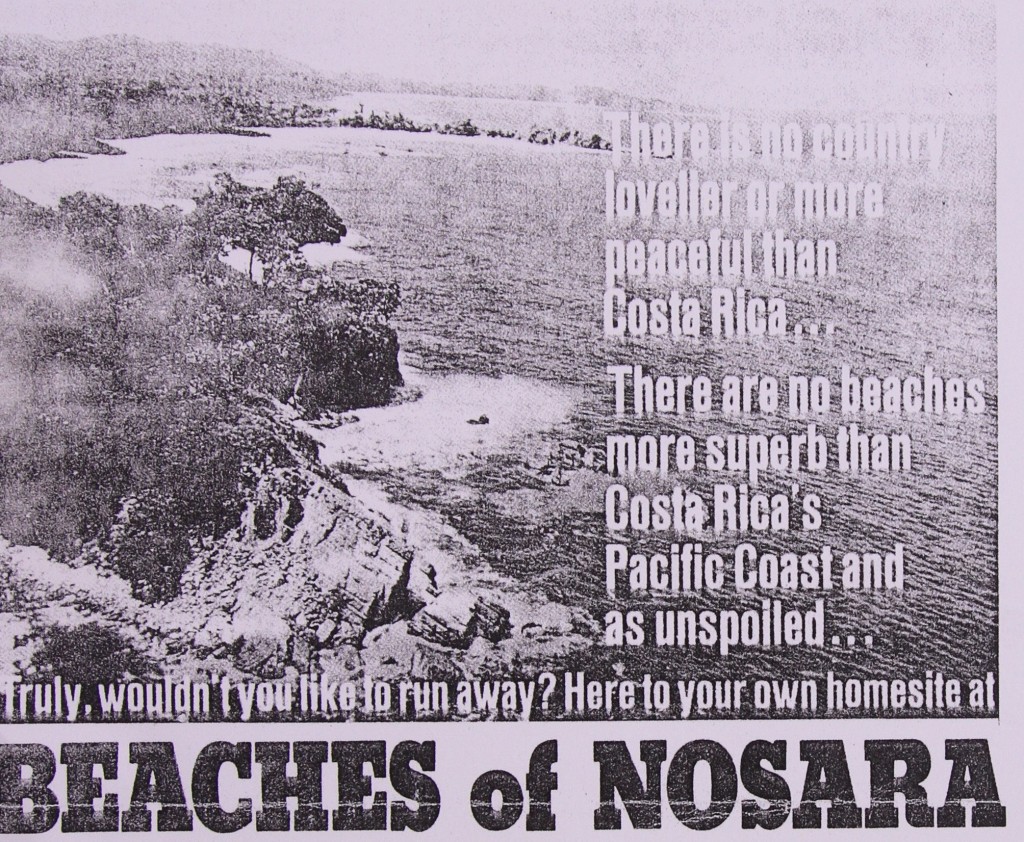Selling Nosara – Part 1 – 1973 American Medical News Promotional Article!
- September 15, 2015
In the late 1960s, a North American property developer named Alan Hutcheson, having grown jaded with the rising prices of land on the Caribbean islands he’d spent the previous decade developing decided to look for somewhere new. The “somewhere new” he found was Playa Guiones.
The plan was simple; relate the untouched beauty, and share the stunning photos with New York City’s finest marketing minds and let them have at it. Have at it they did, and lo and behold, the slice of undisturbed paradise previously unbeknownst to all but a few intrepid ranchers, a handful of locals, and a whole load of howler monkeys hit the headlines. Readers of the New York Times, alongside readers of various highbrow lifestyle publications liked what they saw, and the phones of the sales office began to ring with the same fever that the mailman began delivering the completed coupons at the end of the piece (see the end of the article).
The phrase “the rest is history” although apt, tends to leave an information vacuum. Via the coming series of soon to be released articles, Nosara Real Estate Report intends to try and fill some of that gap by releasing a wealth of material that has come into our possession. This material offers readers a fascinating glimpse into the early days of Nosara and Playa Guiones as a residential community for the adventurously affluent.
Here at Nosara Real Estate Report we strive to share solid information concerning the ‘hows’ and ‘whys’ of past, present and future property prices, and the information contained both herein and to come contain insight regarding why property here is the price it is. People often come to Nosara under the illusion that property prices are low, however tracing these prices back to their roots is an important step to understanding the current climate. The original property buyers contained a large number of trust funders and social elites who often used their property ‘deep in the as Central American jungle” as little more than cocktail party conversation pieces to brag about among the upper echelon of New York social circles. Little did the original developer know, that people would not just show up to buy these properties, but that they would also come to build homes, businesses, and lives in Nosara as expat residents. If this sounds like an overly bold statement we invite you to read this ongoing series of material and see for yourself. The first article in this series features a press release that was published in January 1973 in the American Medical News. What follows has been reproduced verbatim. As well as offering a unique insight into a bygone era in which the written word was still considered an art form, it provides invaluable knowledge for anyone who ever wondered how this all began. Enjoy,,,and stay tuned for the next installment…..COMING SOON!!
The following text has been reproduced verbatim. To view an image of the original material, click the photo in the introduction.
“Truly, wouldn’t you like to run away here to this garden of ours? Doesn’t your bruised spirit need the soft touch of loving people, your tense body the spray of pure, clean air filtered by sunshine? Don’t you long for a place where everyday is gentle summer, where tree wrapped mountains stretch 12,500 feet into the sky, where tumbling streams and waterfalls and wave lapped beaches beg to heal you?
In all truth isn’t it a sort of self-destruction to accept without demur (as maybe you do) the dank cheerless clutch of winter cold – the wintry faces of cheerless people?
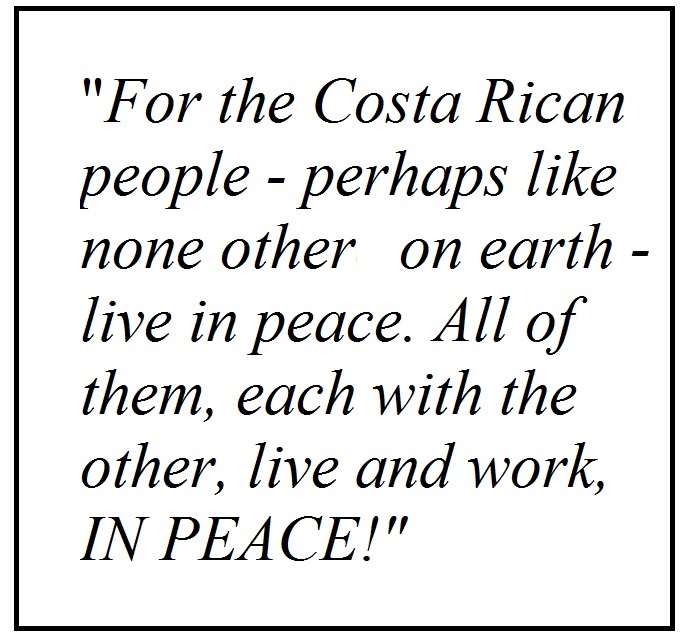 So we ask you again: wouldn’t you like to run away here to a place of your own in this nature blessed country, inhabited by a people who deserve every bit of the beauty they’ve been given? For the astonishing fact is that the Costa Rican people – perhaps like none other on earth – live in peace. All of them, each with the other, live, and work, in PEACE!
So we ask you again: wouldn’t you like to run away here to a place of your own in this nature blessed country, inhabited by a people who deserve every bit of the beauty they’ve been given? For the astonishing fact is that the Costa Rican people – perhaps like none other on earth – live in peace. All of them, each with the other, live, and work, in PEACE!
Consider them, the 1 ¾ million of them: handsome, gentle, literate, industrious and (phenomenon of our times) kindly – a European-sprung people who are constantly embracing, shaking hands, even with strangers, a people to whom law and order is symbolized by a smiling policeman armed with nothing more menacing than a whistle, directing traffic with a murmured “por favor”. The phrase “law and order” doesn’t have an ominous meaning here. It’s incredible for a foreigner to learn that there is no army in Costa Rica (without an army, Costa Ricans say there is no danger of a military takeover). The military uniforms are for police and there are more schools than there are uniforms in Costa Rica. Not alone more school children and more school teachers but actually more schools than military uniforms! Amazing! No wonder that Gov. Nelson Rockefeller, having undergone a rather stormy Latin American tour in 1968, exclaimed happily when he finally got to simpatico Costa Rica: “This perfect jewel of a country!”. The NEW YORK TIMES in an editorial on February 5th 1970 headed “Costa Rica’s Example” praises the solid democracy of this tiny country and says in part: “Doing what comes naturally, a half million voters have brought off (Costa Rica’s fifth successive) peaceful presidential election in twenty years.
Yet, it isn’t only each other whom Costa Ricans like. There is no xenophobia here at all: foreigners are warmly welcomed and North Americans, especially, are cherished. Nearly 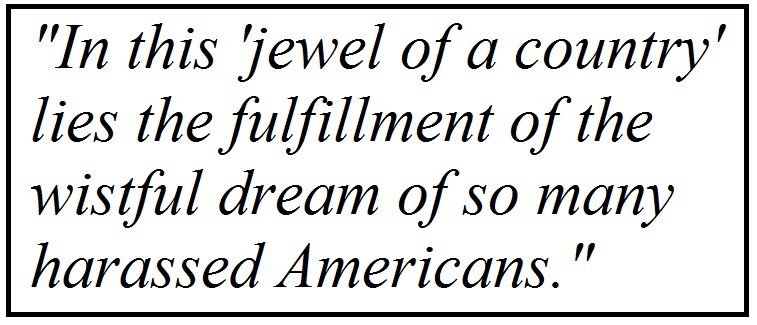 15,000 of us from the U.S. live and prosper in Costa Rica. English is widely spoken, and the word that has been gradually slipping out in this “jewel of a country” lies the fulfillment of the wistful dream of so many harassed Americans: the mind picture of that perfect retreat where climate and man are in gentle harmony with each other.
15,000 of us from the U.S. live and prosper in Costa Rica. English is widely spoken, and the word that has been gradually slipping out in this “jewel of a country” lies the fulfillment of the wistful dream of so many harassed Americans: the mind picture of that perfect retreat where climate and man are in gentle harmony with each other.
It’s rather astonishing that this spectacularly beautiful country, really not that different from the states, is much less familiar to Americans than the islands of the Caribbean. Almost everyone knows, and many have visited, the grouping of tropical Edens called the West Indies – their fabled greenness, the sparkling waters in which they are set. Yet Costa Rica’s climate has all the balm of its’ island neighbors and is more exhilaratingly varied. The sea that stretches along the east coast of this slender strip of Central America is the Caribbean. Go west less than 150 miles and there is the Pacific – nowhere does this greatest of oceans wash more beautiful shores than Costa Rica’s. Incongruously, some travel writers have called this country “ The Switzerland of Central America”; still it as true that Costa Rica’s mountains are as glorious in their tropical setting as the Alps in their ambience. And, it is further a fact that those mountains aid in making the climate the delight it is. San Jose, the capital is in the central plateau, 3500 feet above, and about midway between the Caribbean and the Pacific. The city’s climate is simply nothing less than perpetual spring with the mean temperature steady at 70 degrees every month of the year. But even at Pacific coast sea level – at our beaches of Nosara, for example – even here the mean annual temperature is only 78 degrees accompanied by humidity so low that is can’t be matched by the Caribbean islands. And not to put down the exotic West Indies, there’s a good deal more of Costa Rica that the islands can’t match. Nature thrives on an immense scale here. Naturalists have identified 762 species of birds (in all of the United States, 130 times Costa Rica’s size, there are 725 varieties). And such birds! Parrots, partridge, cuckoos, toucans along with the wrens, thrushes, orioles, finches. We  have deer, raccoon, monkeys. Costa Rica’s soil is so fertile that Texas cattle ranchers are incredulous that what would be prized crop acreage in their state is used casually as cattle raising land here. (It has been reported (THE WALL STREET JOURNAL that Lyndon Johnson bought a ranch on the Pacific side of Costa Rica). And what lush growth springs from the soil Great forest of majestic trees; lignum vitae can be so huge that a single tree’s branches can may shelter an entire herd of cattle. There are groves whose boughs bend under the weight of fruit – citrus, mangoes, bananas, coconuts. Costa Rican coffee is unparalleled. Hundreds of varieties of orchids grow wild. We produce vegetables of a size and flavor such as few North American housewives have ever seen (our portfolio, if you’ll send for it, has photos taken in a market and you’ll find hard to believe those radishes and scallions).
have deer, raccoon, monkeys. Costa Rica’s soil is so fertile that Texas cattle ranchers are incredulous that what would be prized crop acreage in their state is used casually as cattle raising land here. (It has been reported (THE WALL STREET JOURNAL that Lyndon Johnson bought a ranch on the Pacific side of Costa Rica). And what lush growth springs from the soil Great forest of majestic trees; lignum vitae can be so huge that a single tree’s branches can may shelter an entire herd of cattle. There are groves whose boughs bend under the weight of fruit – citrus, mangoes, bananas, coconuts. Costa Rican coffee is unparalleled. Hundreds of varieties of orchids grow wild. We produce vegetables of a size and flavor such as few North American housewives have ever seen (our portfolio, if you’ll send for it, has photos taken in a market and you’ll find hard to believe those radishes and scallions).
Costa Rica has a record of steady economic progress and every foreigner who has come here is instantly aware that this progress is mounting toward affluence. Clearly, a country of such natural richness and with so extraordinary a people, puts fresh meaning into the overworked word opportunity. Oh, opportunity is here, all right. And for none better than for North Americans. There are no restrictions against private investment and the list of American businesses, small and large, is long. For you who simply want to retire, there are special privileges if you are not a Costa Rican, all you have to prove is a guaranteed income of $325 monthly for you and your wife and you are exempt from paying taxes. San Jose has everything – for the soul as well as the stomach. Opera, symphony, splendid movie houses, theater (it’s national theater, marbled an mirrored, is a graceful replica of L’Opera in Paris). Many doctors and surgeons are from U.S. Medical schools; the hospitals are excellent. You can buy anything in the handsome shops and the cost of 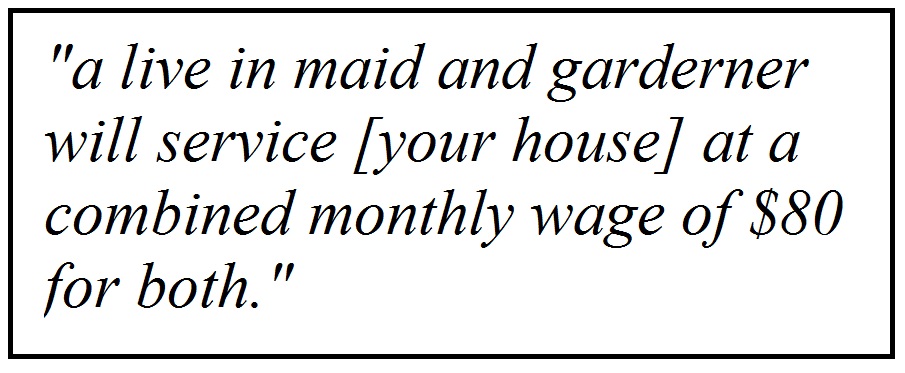 living is joyfully low. T-bone steak, eggs, vegetables, fruits are far below U.S. prices. An elegant Spanish architectural 3 bedroom house can presently be constructed for less than $10,000, and a live in maid and gardener will service it at a combined monthly wage of $80 for both.
living is joyfully low. T-bone steak, eggs, vegetables, fruits are far below U.S. prices. An elegant Spanish architectural 3 bedroom house can presently be constructed for less than $10,000, and a live in maid and gardener will service it at a combined monthly wage of $80 for both.
Education is a positive obsession in Costa Rica. There are 2,379 elementary schools with 350,000 children attending, and 112 high schools, art academies, business schools etc. The beautiful complex of the University of Costa Rica has an enrollment of 12,000 students. And the academic standing of the English language schools is very high. The most prestigious of these accommodates North American children at a tuition of $38 a month. And that includes busing to and from school.
San Jose has a fine airport, one of the largest, most comfortable and modern in Central America, and the jet flight from Miami via LACSA or TACA takes about 2 ½ hours and presently costs $182 round trip. For the autoist the drive from the States along the Pan American highway is memorable one; south of Cartago in Costa Rica, the famous road climbs to it’s highest elevation – 10,931 feet.
So it had to happen. Here we are, a group of Americans – land developers. We’d heard of Costa Rica and we came here, instantly to be entranced by it’s beauty and won by it’s people. We knew quite soon – almost like the original Spanish discoverers who gave it the 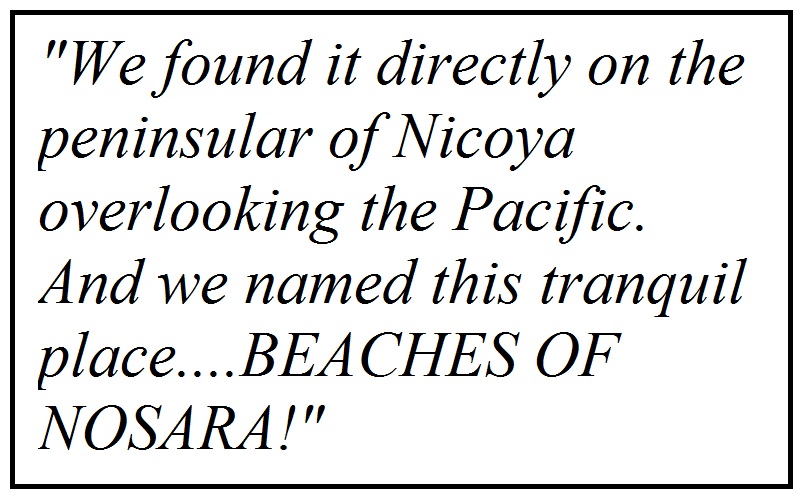 name “Rich Coast” – that this was the country we’d been looking for. All that remained now was to find the quintessential tract of land that had everything – natural loveliness, serenity, climate, beaches. We found it. We found it in the peninsula of Nicoya directly on the Pacific. And we named this tranquil place….BEACHES OF NOSARA….
name “Rich Coast” – that this was the country we’d been looking for. All that remained now was to find the quintessential tract of land that had everything – natural loveliness, serenity, climate, beaches. We found it. We found it in the peninsula of Nicoya directly on the Pacific. And we named this tranquil place….BEACHES OF NOSARA….
We’ve employed many superlatives in this ad – maybe, you’ll suspect, even extravagances. Yet at the risk of once more stretching your bounds of credibility, we say this: that nowhere in the world will you find more glorious beaches than the two miles of beautiful white sand, and unimaginably clean, clear sea that front our property. There is one section that is modestly compared to the best surf Hawaii has to offer; and wonderfully for the less adventurous, there is a long piece where the sea is quiet and even infants can play in the water as it rolls gently onto the sand. If you’re a shell collector you’ll find, day after day, specimens you’ve never before seen. And out from shore are the boating and skin diving, the fishing. A world of fish, a treasure-house for you, if that’s your passion: tuna, dolphin, wahoo, grouper, snapper – the whole catalog, believe it. How rare to discover that today – a pure sea teeming with healthy fish. Yes, as much as anything it was the ocean and the beaches that caused us to choose Nosara.
But then one turns his back on the Pacific and looks out at the land and isn’t that something to see – this rich soil, lushly covered sculpture of hills and valleys! It is big – 3300 acres – but we intend to convert only a part of it to homesites, we’ve brought in  ecologists and other scientists to help us preserve that natural beauty of this place. We have laid about 35 miles of horseriding trails, all within the boundaries of our property. If a precious tree stands in the way of a bulldozer the tree stays; we bend the road around it. If it’s to be a match-up between “progress”; and nature we’ll ride with the trees and the birds.
ecologists and other scientists to help us preserve that natural beauty of this place. We have laid about 35 miles of horseriding trails, all within the boundaries of our property. If a precious tree stands in the way of a bulldozer the tree stays; we bend the road around it. If it’s to be a match-up between “progress”; and nature we’ll ride with the trees and the birds.
But of course we’ve brought in the machines and used them. Every site in beaches of Nosara fronts a road. Every home is guaranteed electricity and pure delicious water. We hope to build a superb golf course with 9 holes to be completed next year in 1973. And we  expect to build the first of our tennis courts shortly. We’ve built a charming hotel with club facilities and an airfield to bring you here quickly from San Jose.
expect to build the first of our tennis courts shortly. We’ve built a charming hotel with club facilities and an airfield to bring you here quickly from San Jose.
We’re not new to this profession. We’ve been developers in the West Indies and we do apreciate those magical islands. But this is the simple truth: no island in the Caribbean can claim what we have in this ad. And when one realizes that some improved sites in the West Indies have now soared to fantastic prices – that one dollar a square foot, $10,000 for a quarter acre is now becoming the rule, then beaches of Nosara becomes almost too good to be true. For the price of our home sites is only 40 cents per square foot, $4000 for a quarter acre, 4% down and 2% a month, with no interest charges! And that includes roads, electricity, water, one year free golf membership, and the unlimited use of the natural paradise that we’ve inherited and are preserving for you.
We’re running out of space and there’s so much more to tell you. Some of you may visit us after reading this message. Most can not. For those we have prepared a thick portfolio. It includes a large color brochure, maps, house plans, and a 96 page condensation of professor Donald Lundberg’s authorative book “Costa Rica”. All this is free.
Our portfolio also tells you how to go about reserving a homesite in beaches of Nosara and spells out out money back guarantees: an unconditional 60 day deposit refund warranty; and a full year after signing contract to visit the property and see for yourself whether it delights you. If not, every penny you’d have paid in is refunded without a word.
We are quite certain that we have something very special in beaches of Nosara and we already know that the response to our advertising is going to be quite lively. We sincerely urge you – if you wish to be in time for the choice lots – to fill out and mail the coupon right away. Our portfolio is free and you are under no obligation at all. Indeed, no-one will ever phone you or call on you. It’s only the mail man you’ll see.”


